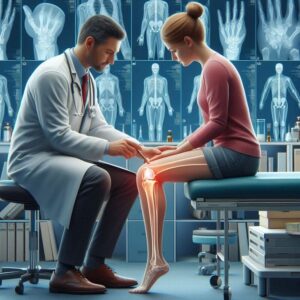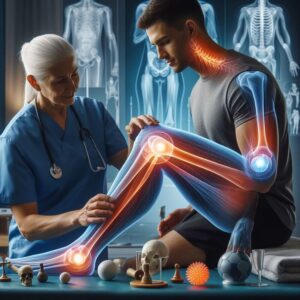Degenerative osteoarthritis affects one-third of the population over time. Knowledge about it is crucial to managing and treating this condition effectively. Discomfort and suffering brought on by degenerative osteoarthritis can have a profound impact on an individual’s standard of living. People who are informed about the disease and its origins, symptoms, and options are more likely to take responsibility for their health and make the most of available resources.
What is Osteoarthritis Degeneration?
Degenerative joint disease, more often known as osteoarthritis, is a condition that can affect the joints of the body. The protective cartilage that encases the ends of bones in a joint degrades and finally wears away. The bones rub against one another due to cartilage wear and tear, which causes irritation, discomfort, and stiffness.
When this condition shows up, the patient’s hips, knees, and spine suffer the most. It can also affect the joints in your hands and feet. Osteoarthritis degeneration often worsens with time if left untreated.

Causes and Risk Factors of Osteoarthritis Degeneration
There are several common causes of osteoarthritis. Significant factors include the wear and pressure on joints caused by ageing. As we age, the cartilage that protects our joints gradually wears away, which may lead to the onset of degenerative osteoarthritis.
Degenerative osteoarthritis can develop for a variety of reasons, including genetics, excess body fat, damage to the joints, or repeated stress injuries. Individuals with particular predisposing characteristics have a higher chance of experiencing it. Having a personal or family history of the illness, being overweight or obese, having a history of joint discomfort or surgery, and using the joints too much from repetitive motions are all factors that increase the likelihood of developing this condition. Motions.
Symptoms of Degenerative Osteoarthritis
| Symptoms | Description |
|---|---|
| Pain | Steady or intermittent pain in the affected joint |
| Stiffness | Difficulty moving the joint, especially after periods of inactivity |
| Tenderness | The joint is sensitive to touch or pressure |
| Swelling | The joint may appear larger than usual due to inflammation |
| Cracking or popping | Audible sounds when moving the joint |
| Decreased range of motion | Difficulty moving the joint through its full range of motion |
| Bone spurs | Bony growths that can develop around the affected joint |
Depending on the extent of joint destruction and the number of affected joints, the symptoms of degenerative osteoarthritis can be mild, moderate, or severe. Many people report diminished mobility, swelling, pain, and joint stiffness. Specific individuals suffering from osteoarthritis may perceive a grating or grinding noise.
These symptoms can greatly impact everyday living. Stiffness or soreness in the joints can make even the simplest tasks, like getting dressed, difficult. Pain and discomfort not only make it difficult to sleep but also negatively impact one’s quality of life in general.
Diagnosis and Tests for Osteoarthritis Degeneration
A review of medical history and a physical examination can diagnose degenerative osteoarthritis. Radiographs or magnetic resonance imaging (MRI) scans can help doctors evaluate the patient’s joint health and identify any underlying issues that could be causing their symptoms.
In some cases, checking joint fluid for signs of inflammation or infection may be necessary. This is accomplished by sending a small fluid sample from the affected joint to a lab for analysis.

Different Types of Degenerative Osteoarthritis
Degenerative osteoarthritis can be grouped into different types depending on the joints that are impacted. Knee osteoarthritis is a common kind of arthritis. One kind impacts the hips, while the other targets the spine.
Osteoarthritis symptoms, indications, and potential therapies might differ significantly. For example, it can make it difficult to move about and cause pain in the knees, while in the back, it can cause stiffness and discomfort.
Treatment Options for Osteoarthritis Degeneration
Numerous effective treatment options exist for osteoarthritis. Treatment goals include reducing discomfort, improving joint function, and halting the course of the illness. Surgery, behavioural changes, medication, exercise, and physical therapy are all potential components of a comprehensive treatment programme.
Treatments for Dementia Knee and joint pain
Medicine can alleviate pain and inflammation in degenerative osteoarthritis. An NSAID, such as ibuprofen or naproxen, helps reduce swelling and discomfort. Paracetamol is an additional option for pain relief.
Corticosteroid injections are occasionally recommended as a temporary fix for inflammation and discomfort. Injecting these drugs directly into the injured joint is standard procedure.
Since any prescription has the potential to have side effects, it is advisable to discuss the benefits and risks of medication with your doctor before starting therapy.
Modifications to Habits for the Control of Ageing Osteoarthritis Discomfort
Some people find relief from the pain of degenerative osteoarthritis by making changes to their lifestyle. For instance, the joints that support your body weight—your knees and hips—are spared more wear and tear when you keep a healthy weight. Incorporating omega-3 fatty acid-rich seafood and almonds into a well-rounded diet is another strategy for reducing inflammation.
One way to improve joint function is to exercise regularly to strengthen the muscles around the affected joints. Swimming, cycling, and walking are low-impact activities usually recommended for people with osteoarthritis. Get the OK from your doctor or PT before starting any new exercise programme.

Physical Therapy and Exercise for Osteoarthritis Degeneration
Physical therapy techniques, specific exercise programmes, and lifestyle changes can better manage degenerative osteoarthritis. Range-of-motion exercises can improve joint flexibility, and strengthening activities can strengthen the affected joint for extra support.
Physical therapy may use ultrasound, electrical stimulation, and heat or cold treatments, among similar methods, to manage pain and improve joint function. A physical therapist may design a personalised therapy plan based on each patient’s specific needs and goals.
Regenerative Surgery: How Often Does Osteoarthritis Occur?
In some cases, surgery may be necessary to treat degenerative osteoarthritis. Surgical alternatives to joint dissection include joint replacement surgery, which involves implanting a prosthetic joint into the damaged joint, and arthroscopy, which involves putting a tiny camera into the joint to remove diseased tissue or rebuild cartilage.
Surgical intervention is an option to explore when other therapeutic options have been exhausted or when the condition significantly impacts everyday functioning. A wise person would talk to their doctor about the pros and cons of surgery before deciding to have it done.
Degenerative osteoarthritis, a typical kind of osteoarthritis, can cause significant discomfort. If informed about the disease and its origins, symptoms, and alternatives, people may take responsibility for their health and make the most of osteoarthritis treatment options. Early diagnosis and therapy can slow the course of degenerative osteoarthritis and improve symptoms and quality of life. As a result, seeking medical help is essential if you’re experiencing any symptoms.
If you want to learn more about effective treatments for degenerative osteoarthritis, you may find this post on plantar fasciitis and identifying remedies helpful. Plantar fasciitis is a common foot ailment with several symptoms of degenerative osteoarthritis, such as inflammation and discomfort. This article provides insightful information on managing these disorders and the many therapeutic options available. Check it out here.
FAQs
What is Degenerative Osteoarthritis?
In degenerative osteoarthritis, the cartilage in the joints gradually deteriorates, leading to joint stiffness, oedema, and discomfort.
What are the symptoms of Degenerative Osteoarthritis?
Degenerative osteoarthritis is characterised by joint stiffness, oedema, discomfort, and reduced mobility. These symptoms might get worse as time passes.
What causes Degenerative Osteoarthritis?
The leading cause of degenerative osteoarthritis is the degradation of joint cartilage. Age, heredity, trauma, and excess body fat are among the variables that might bring about this deterioration.
How is Degenerative Osteoarthritis diagnosed?
Imaging studies like X-rays or MRI scans, a thorough medical history, and a physical examination are usually used to diagnose osteoarthritis.
What are the treatment options for Degenerative Osteoarthritis?
Managing pain, engaging in physical therapy, losing weight, and, in extreme circumstances, surgery are all potential treatments for degenerative osteoarthritis. Administering corticosteroids and nonsteroidal anti-inflammatory medicines (NSAIDs) is also possible.
Can Degenerative Osteoarthritis Be Prevented?
There is no known way to avoid acquiring degenerative osteoarthritis altogether, although measures may be taken to lower the risk. You should do your best to prevent harm to your joints, keep active, and maintain a healthy weight.
References
How Long Do Glucosamine and Chondroitin Take to Work? Fuel Organic Vitamins: https://fuelorganics.com/blogs/learning-center/how-long-do-glucosamine-and-chondroitin-take-to-work
Does arthritis make you tired? | BCR. https://bcr.org/2023/07/24/does-arthritis-make-you-tired/
The Post: Degenerative Osteoarthritis – Understanding the Pain appeared first on MCR Preston.
The Article Pain in Degenerative Osteoarthritis: A Comprehensive Guide appeared first on MCR Therapies.
The Article Pain in Degenerative Osteoarthritis: A Comprehensive Guide Was Found On https://limitsofstrategy.com


This is such an important discussion on degenerative osteoarthritis, as it often goes underrepresented despite its prevalence. My grandmother lived with osteoarthritis for many years, and it was eye-opening to witness firsthand how it impacted her daily life—from seemingly simple tasks like buttoning her shirt to enjoying family gatherings.
I appreciate you sharing your experiences with your grandmother. It’s incredible how much we can learn by observing the challenges others face, especially in matters as impactful as osteoarthritis. It really brings to light how even small actions—like buttoning a shirt—can become significant hurdles for someone living with this condition.
I really appreciate your insights on this. It’s true – when you look closely, the smallest tasks can take on a whole new level of difficulty for someone dealing with something like osteoarthritis. I remember watching my grandmother struggle with everyday things, like using a simple zipper or tying her shoes. It’s easy to take for granted how much we rely on those small movements until they become a challenge.
You’re so right about the small things having a big impact. Watching my grandmother navigate her day-to-day tasks opened my eyes to how much we take for granted. Simple actions, like twisting a cap off a bottle or getting dressed, can turn into challenging battles for someone with osteoarthritis.
It’s so true how those small tasks can turn into monumental challenges. My own experience with my grandfather, who also dealt with osteoarthritis, opened my eyes to that same reality. I remember how he used to meticulously plan his outings around what he could manage without feeling overwhelmed, and it really highlighted the need for empathy towards those facing such struggles.
It’s true—observing the day-to-day challenges faced by someone with osteoarthritis really underscores how we often overlook the intricacies of seemingly simple tasks. I’ve seen how my grandmother’s struggle with things like tying her shoes or even opening a jar can transform her daily routine into a series of obstacles. It’s a poignant reminder of how much we take for granted in our own abilities.
You really hit on something profound with that observation. It’s easy to forget how much we rely on our physical abilities until we see someone close to us facing those everyday challenges. Your grandmother’s experiences sound like they’ve given you a deeper insight into the importance of adaptability and patience.
You’re so right—it really does take those moments of seeing someone we care about struggle to make us realize just how much we take our own abilities for granted. My grandmother’s journey has taught me that adaptability isn’t just about changing how we do things; it’s about embracing new ways of thinking and being present.
It’s so true how those moments of witnessing a loved one struggle can really shift our perspective. I think about my own experiences with family, particularly with my parents as they navigated health challenges. It was a wake-up call for me, too—realizing the resilience they showed and how much we can take for granted in our daily routines.
It’s interesting how those experiences really do change the way we see life. When we watch our loved ones face challenges, it can shake us out of our routines and make us recognize the little things we often overlook. I remember a similar moment with my own family; it was a turning point. Seeing my parents’ strength and how they approached their health with such grace made me rethink my own priorities.
You’ve really nailed it. Watching my grandmother tackle those daily obstacles has definitely reshaped how I see things. It’s wild how people often take their physical abilities for granted until they’re challenged. Each small task becomes a lesson in resilience and creativity. I often start to reflect on how adaptable we can be in different situations—it’s almost like a hidden skill we all possess, just waiting to be unveiled when times get tough.
It’s interesting how witnessing someone tackle challenges can shift our perspective, isn’t it? Your grandmother’s approach highlights a fundamental truth: often, when we face obstacles, innovation and determination come to the forefront. I think it’s fascinating to reflect on those everyday actions—each one a small victory that keeps her engaged with life in meaningful ways.
You’ve really touched on something important here. It’s fascinating how the little things can accumulate to create significant challenges, isn’t it? I’ve seen similar struggles in my own family, particularly with my dad who dealt with arthritis in his hands. Simple tasks like buttoning a shirt or even using a fork can become daunting hurdles. It makes you realize just how intertwined some of our self-sufficiency is with our physical capabilities.
You’re right, the accumulation of those little challenges can really shift our perspective on daily tasks. It’s striking to see how quickly our physical capabilities can affect our sense of independence and self-sufficiency. I can relate to what you’re saying about your dad; it’s heartbreaking when something that seems so simple for many becomes a significant hurdle for someone we care about.
It really is eye-opening how those everyday tasks can turn into major obstacles when physical limitations come into play. Your dad’s experience with arthritis resonates with a lot of people, including myself. I remember my grandmother struggling with similar issues; the frustration she faced with simple acts like holding a spoon or putting on her favorite cardigan seemed to overshadow other aspects of her life.
You’ve captured that experience beautifully. It’s striking how the simplest actions can become monumental challenges for someone with osteoarthritis. I’ve seen similar struggles in my own family—my aunt has it, and her fight with daily activities like getting dressed or cooking has opened my eyes to the realities of living with chronic pain. It truly does transform not just her routine but the way we all engage with her.
You’ve captured a crucial point about how daily tasks take on a new meaning for those living with osteoarthritis. Observing my grandmother navigate her day-to-day life really highlighted how something as simple as buttoning a shirt or opening a jar can turn into a significant hurdle. It’s humbling to realize how those small actions, which many of us take for granted, can require so much effort and thought for someone dealing with chronic pain.
It’s fascinating how something often regarded as a simple “ache and pain” can really pull the rug out from under us. Your mention of your grandmother struggling with those everyday tasks hits home—like trying to convince those pesky buttons to cooperate. It’s wild how they can become tiny adversaries in the battle of life, right?
It’s striking how personal experiences like your grandmother’s can shine a light on the reality of osteoarthritis. It brings to mind the countless individuals out there whose daily lives are altered significantly by this condition, often without much public awareness. What stands out is not just the physical pain, but the ripple effect it has on personal connections and everyday joys, like family gatherings. Simple moments can become daunting challenges for someone living with osteoarthritis.
It’s striking how the impact of osteoarthritis often gets sidelined in conversations about health. Your observations about your grandmother’s daily struggles with tasks that many take for granted shed light on the real, day-to-day challenges people face. Osteoarthritis doesn’t just affect joints; it influences emotional well-being and one’s sense of independence.
I really appreciate how you’ve highlighted the significance of understanding degenerative osteoarthritis. It’s a condition that seems to fly under the radar for so many people, yet it has such a profound impact on daily life. Just the other day, I was chatting with a friend who has been struggling with osteoarthritis in her knees. She mentioned how something as simple as climbing stairs or walking her dog has become a challenge. Those small, everyday activities that many of us take for granted suddenly become monumental tasks.
I completely resonate with what you’re saying about the impact of degenerative osteoarthritis on daily life. It’s easy to overlook conditions like these until someone close to you shares their experiences. Your friend’s struggles with simple tasks like climbing stairs or walking her dog really highlight how vital mobility is to our overall well-being.
You’ve touched on something really important. Mobility is such a foundational part of our lives, and when it’s compromised, it can really shift our perspective on everyday activities. It’s often these little things—like the joy of walking a dog or climbing stairs—that we take for granted until a condition like osteoarthritis makes them challenging.
Ah, degenerative osteoarthritis—the gift that keeps on giving, much like that one relative who overstays their welcome at family gatherings! It’s wild how something as simple as “let’s get moving” can turn into a game of “how many pills can I take before I feel human again?”
This is such an important topic to dive into, and I appreciate how you highlighted the impact of degenerative osteoarthritis on daily life. It’s fascinating – and somewhat alarming – how common it is, affecting one-third of the population over time. I’ve seen it firsthand with my aunt, who has struggled with osteoarthritis in her knees for years. It really disrupts not just her mobility, but her entire routine.
It’s really eye-opening to hear about your aunt’s experience. Osteoarthritis can be such a relentless condition, and it’s true that it reaches far beyond just physical discomfort. The impact on daily life can be profound—everything from simple tasks like getting out of a chair to more enjoyable activities can change dramatically.